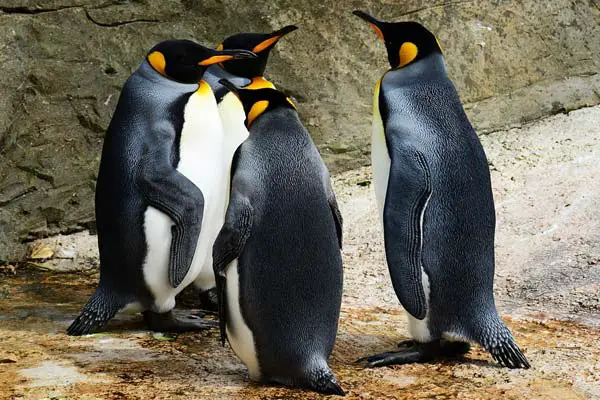Penguins are fascinating creatures that have captured the hearts of many people worldwide. One question often arises when discussing penguins is whether or not they have tails. The answer to this question is yes, penguins do have tails, but they are pretty different from the tails of other birds.
Unlike most birds, which have long, thin tails that stick out from the back of their bodies, penguins have short, stubby tails that are wedge-shaped.
These tails are made up of 14 to 18 stiff tail feathers and are used for various purposes, including steering in the water, balancing, and preening or cleaning. While the length of a penguin’s tail can vary depending on the species, they are typically between 3-12 inches long, with the emperor and king penguins having slightly longer tails at 8-9 inches.
Despite their short tails, penguins are incredibly agile swimmers and use their flippers to move quickly through the water. Their tails, although small, play an essential role in helping them navigate their aquatic environment.
Penguin Tail Anatomy and Function
Penguins are known for their unique appearance and ability to swim gracefully in the water. One of the features that make penguins stand out is their tails. Yes, penguins have tails, an essential part of their anatomy.
Description of a Penguin’s Tail and its Purpose
A penguin’s tail is a short, stiff structure covered in feathers. The wedge-shaped tail helps the penguin steer and balance while swimming. The tail also functions as a rudder, allowing the penguin to change direction quickly and efficiently.
The tail feathers are also crucial for preening and cleaning. Penguins use their beaks to spread oil from a gland near their tail feathers over their feathers to keep them waterproof. This is important for maintaining their body temperature in cold water.
Tail Variations Among Penguin Species
Different species of penguins have tails of varying lengths and shapes. For example, the Adélie penguin has a short, stiff tail used for balance when walking on land.
The chinstrap penguin has a slightly longer tail for steering while swimming. The gentoo penguin has a more upright tail, which helps it to maintain balance on rocky terrain.
Penguin Tails and Survival
Penguin tails are essential for the survival of these aquatic birds. They help penguins to swim and catch fish, which is their primary source of food. Penguins also use their tails to escape predators such as seals and sea lions.
Researchers have studied the anatomy and function of penguin tails to understand these fascinating birds better. Scientists have studied their movements and behavior by attaching trackers to penguins, including how they use their tails while swimming and diving.
Importance of Penguin Tails
Penguin tails may seem insignificant, but they play a crucial role in the survival of these flightless birds. Here are some of the ways penguins use their tails:
Swimming and Maneuvering
Penguins are excellent swimmers whose tails are vital in their aquatic locomotion. The tail feathers act as rudders, helping them change direction and maintain swimming stability. Penguins can also use their tails to propel themselves forward in the water, especially during short bursts of speed.
Tail Communication and Signaling in Penguins
Penguins use a variety of vocalizations and body language to communicate with one another, and their tails are no exception. When penguins are courting or mating, they may wag their tails to signal their intentions. Some penguins also use their tails to display aggression or warn off potential predators.
FAQs about Penguin Tails
Do All Penguins Have Tails?
Yes, all 18 species of penguins have tails. However, the length of the tail varies from one species to another. For example, the emperor and king penguins have tails 8-9 inches long, while other species have shorter tails ranging between 3-12 inches.
Length and Characteristics of Penguin Tails
Penguin tails are short and stubby, with feathers. They are wedge-shaped and have 14 to 18 stiff tail feathers. Penguins use their tails for steering in the water, balancing, and preening or cleaning. Scientists also study penguins’ tails to learn more about their behavior and ecology.
Common Misconceptions About Penguin Tails
One common misconception about penguin tails is that they are used for flying. However, penguins are flightless birds and cannot fly. Another misconception is that penguins use their tails to keep their eggs warm. In reality, penguins use a particular brood patch on their belly to incubate their eggs.
Conclusion
In conclusion, the answer to the question “Do penguins have tails?” is a resounding yes. All 18 species of penguins have short tails and stubby flippers with feathers. The length of a penguin’s tail can vary but typically ranges between 3-12 inches.
While penguins’ tails may not be as prominent as those of other birds, they serve an essential purpose in helping penguins maintain their balance while swimming and walking on land. Some penguins, such as the Adélie, Gentoo, and chinstrap penguins, have longer tail feathers used as a prop when on land.
It is important to note that penguins have more feathers than most other birds, with about 100 feathers per square inch. These feathers are essential for keeping penguins warm in their cold aquatic habitats.

